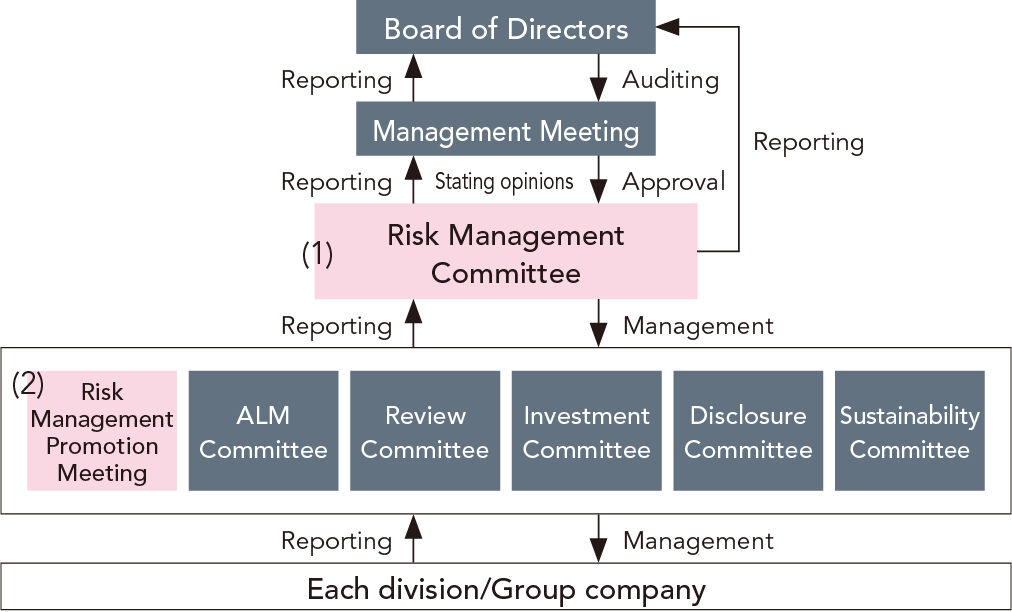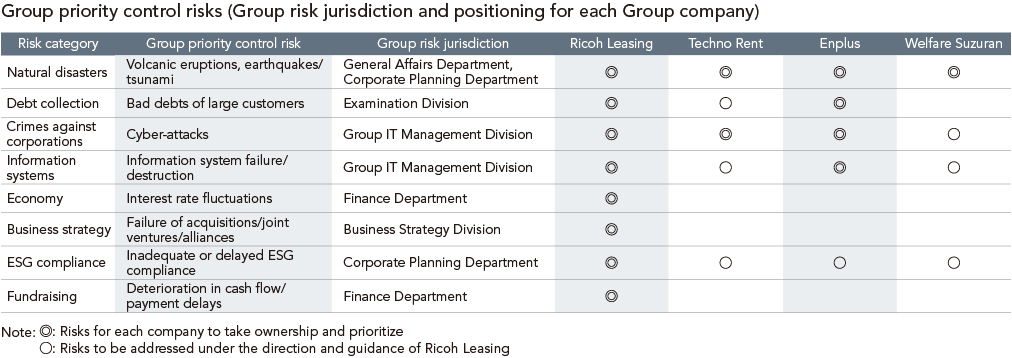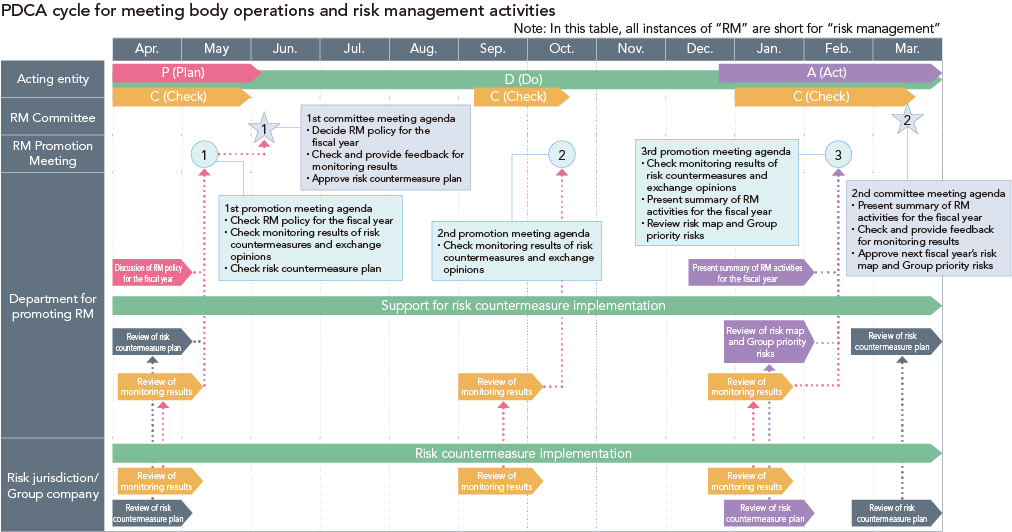Our approach to risk management
In order for a company to achieve stable and sustainable development, to increase corporate value, and to fulfill its corporate social responsibility, it is essential to accurately address risks that could have a significant adverse impact on corporate activities. The Ricoh Leasing Group is implementing effective and efficient risk management by comprehensively and exhaustively identifying, organizing, and addressing the risks that surround the Group.
Review and establishment of risk management structure
Structures for risk management must be continuously reviewed and improved to adapt to an ever-changing environment. Until now, risk management of the Ricoh Leasing Group has been the responsibility of each Group company to act based on their own best judgment. In strengthening Group management growing forward, optimal decisions must be made to maximize profits for the entire Group. Factors that may hinder the realization of this goal must be identified, analyzed, and evaluated as risks, and a review of the risk management system is underway to this end.
Risk Management Promotion Structure

(1)Risk Management Committee
To manage risks that could significantly affect the Group's business, we have established the Risk Management Committee, chaired by the Company's President and Chief Executive Officer and composed of members of the Management Meeting and the presidents of Group companies. We are working to strengthen risk management by designating control items that we consider highly important in the management of the Group as Group priority control risks, and we are managing and monitoring these accordingly. Important matters are discussed by the committee and then reported to the Management Meeting and to the Board of Directors.
<Roles of the Risk Management Committee>
- Determination of risk management policy and annual plan
- Determination of Group priority control risks and risk jurisdiction
- Determination of risk countermeasure plan
- Confirmation and feedback on the implementation status of risk countermeasures
(2)Risk Management Promotion Meeting
The Risk Management Promotion Meeting has been newly established to promote smooth Group risk management in close cooperation and collaboration among the Company and its Group companies. It is composed of the jurisdictional manager of Group priority control risks and the person responsible for promoting risk management at Group companies. This meeting shares not only the status of plans and responses to the Group's priority control risks, but also risk information and countermeasure status at each company, and reports to its parent body, the Risk Management Committee, after discussions.
Risk assessments
We have created a risk map that identifies and prioritizes risks in the Company and its Group companies from the perspectives of internal environment, external environment, and management strategy, and by conducting risk analysis and risk assessment.
The magnitude of risk is measured on two axes: magnitude of impact on occurrence and likelihood of occurrence, and items with high risk are designated as Group priority control risks.
Risk map and risk assessment criteria

Group priority control risks
The Ricoh Leasing Group risk jurisdiction is responsible for the overall cross-organizational management of Group priority control risks in particular. It formulates and promotes risk countermeasure plans, instructs Group companies and related departments to implement risk countermeasures and confirms the status of implementation, and reports to the Risk Management Promotion Meeting.
In addition, each Group company will establish its own priority control risks to be managed and implement risk management accordingly. After management decisions are made at each company, plans and implementation status of specific priority management risks are reported to and shared with the Risk Management Promotion Meeting to achieve integrated Group risk management.
Group priority control risks
(Group risk jurisdiction and positioning for each Group company)

Risk management process
Considering that the various actions related to a single risk cannot be encapsulated into a single fiscal year, the Group has set a three year risk management cycle, implementing the PDCA cycle for the planning, implementing, and monitoring of countermeasures. Ensuring a sufficient period of time regarding implementation, evaluation/ monitoring, and improvement will enhance the effectiveness of the measures. The Risk Management Promotion Meeting is held three times a year. In May, the meeting decides the countermeasure plan for the current fiscal year, while in February, after an interim report, the annual summary and Group priority control risks for the next fiscal year are finalized at the Risk Management Committee.
PDCA cycle for meeting body operations and risk management activities

Business continuity planning (BCP) and disaster control
Drawing on lessons from the Great East Japan Earthquake, the Company has developed an action manual to ensure that each employee can respond appropriately to disasters. We conduct annual disaster drills in each region and, as of fiscal 2023, we carry out disaster response drills jointly conducted by the Ricoh Leasing Group.
In this training, we divide activities into initial responses in the event of a disaster (on-site activities) and BCP (headquarters activities) so that we can respond smoothly when an actual disaster occurs.
Upon receiving certification as a model company that promotes staggered returns home, we purchased enough sleeping bags and pillows, including the usual emergency supplies, for all employees commuting to our major sites in Japan, including the head office, to ensure a safe environment even if employees cannot return home. In addition, we distributed TVs and storage batteries to enable access to disaster information at major sites and ensure the continuation of activities until the restoration of infrastructure.
We also introduced IP radios as a means of communication with each site, enabling communication regarding the disaster status and consideration of countermeasures at all Group companies.
A new safety confirmation system has been introduced to collect information on the safety of Group company employees in the event of a disaster. In addition, we are taking Group action for disaster prevention, putting employee safety first by notifying employees not to go to work or leave the office unnecessarily in the event of a typhoon or heavy rain or snow forecast.
| Fiscal year | Main Initiatives |
|---|---|
| 2018 |
|
| 2019 |
|
| 2020 |
|
| 2021 |
|
| 2022 |
|
| 2023 |
|
Value Chain Management
Companies are required to operate their businesses with an awareness of social responsibility, such as the impact and scope of influence of their business activities.Among these, there are companies and people involved in the supply chain, and it is important to consider avoiding or minimizing unintended negative impacts such as human rights, labor, and the environment.
Based on our Management Philosophy, our group carries out initiatives aimed at achieving a sustainable society based on our Approach to Sustainability.We are committed to contributing to the resolution of social and environmental issues through our company activities and playing an active role in building a sustainable society. For businesses and companies that have a large negative impact on society, we are taking action in accordance with the Policy on Social and Environmental Considerations in primarily in Loans Investment, which prohibits or restricts primarily in Loans investments.We are aware that reliable collection and proper disposal of leased products is an important responsibility of the leasing company, and we regularly and continuously conduct on-the-spot inspections of our partners who are consigned to collect and recycle the products.
Quality Management
The quality of products and services provided to customers and society is an important condition for sustainable development in a changing society.Quality problems may also develop into substantial losses in management.Quality control is an activity in which everyone from the top to the front-line employee participates to improve and manage their way of doing their work.In addition to our traditional activities, we have recently been promoting efforts to instill the idea that processes need to be improved in order to improve quality (improve results).The main activities are the "TTY (What then Why) Training" that aims to improve the ability to detect and resolve issues.We are promoting fundamental problem-solving activities by establishing concepts and skills for identifying problems, visualizing facts, investigating the causes of the problems through factor analysis, and then taking countermeasures.
